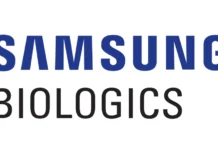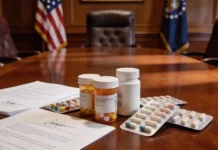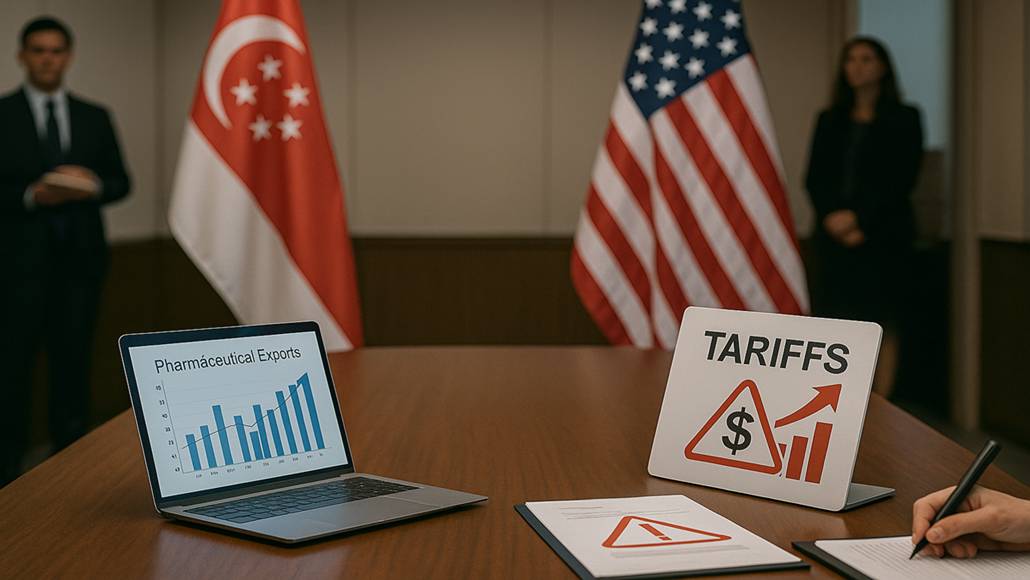The deputy prime minister and trade minister of Singapore, Gan Kim Yong, has announced his plans to visit Washington this July in order to negotiate certain pharmaceutical tariff concessions on exports, thereby looking forward to shielding one of the most vital industries of the country from the widening US-led trade conflict. Although Singapore has not yet received a direct tariff warning letter from President Donald Trump’s administration as yet, its exports are still subject to a 10% baseline tariff, which is imposed under the reciprocal trade policy, which was initiated in April 2025. In spite of a free trade agreement with the US, since 2004, the higher-value pharmaceutical as well as electronics shipments from Singapore remain exposed to new levies, thereby raising concerns when it comes to the integrity of established trade practices along with certain economic effects on export-dependent sectors.
Tariff escalation happens to pose a risk to semiconductor as well as pharma trade
The recent announcement by the Trump administration of a 50% copper tariff, as well as the planned extension of tariffs on semiconductors along with pharmaceuticals, has raised alarms in Singapore, which happens to be a nation where advanced manufacturing along with biopharmaceuticals comprise almost 40% of overall exports to the United States, as per the Monetary Authority of Singapore. The vulnerability of the island happens to lie in the sector-specific nature of the present trade war, since broad industrial categories go on to fall under the retaliatory scope of Washington.
The minister went on to note that while the discussion when it comes to semiconductors has not started yet, they happen to remain a priority once the pharmaceutical issues are settled. The global semiconductor supply chain integration of Singapore, both as a producer as well as a logistics hub, makes it a potential collateral victim when it comes to the broader technology decoupling that has happened between the US as well as Asia.
As the front-loading has faded, the domestic outlook is cautiously revised
Gan also went on to flag slowing economic momentum within the second half of 2025, with earlier growth sustained primarily because of front-loaded exports, which were ahead of anticipated tariff hikes. The Ministry of Trade and Industry has already lowered the GDP growth projections in April 2025 to hover between 0% and 2% from the erstwhile 1% to 3% outlook. The revision goes on to reflect the repercussions of both the direct impact of tariffs along with the anticipated decline in external demand since global supply chains have reshuffled.
As Singapore is deeply embedded within both Western as well as Asian trade networks, the convergence of US protectionism along with Chinese countermeasures happens to create a very specific, delicate, diplomatic as well as economic balancing act. The latest warning by China of retaliation against countries that are supporting the US supply chain alignment highlights that the geopolitical tightrope has to be navigated by Singapore.
Trade diplomacy, which is under pressure
The urgency of the upcoming negotiations by Singapore happens to be compounded by the letters from Trump to 22 countries recently, which include very close allies like South Korea and Japan, thereby outlining tariffs of 20 to 50% that are going to set to take effect from August 1. While Singapore has not received any such letter yet, the uncertainty that is surrounding the sector-specific enforcement happens to mean that even countries that are not directly named may face the second-order effects by way of decreased global trade flows and even redirected capital.
Gan has gone ahead and adopted a carefully structured approach to trade relations and prioritize the stabilization of the pharmaceutical sector before going ahead and addressing the complex semiconductor industry. This kind of phased strategy is designed in order to minimize economic exposure and at the same time allow with a measured progress in trade negotiations. By way of focusing first on pharmaceuticals, which is a critical sector with direct implications for public health as well as domestic stability, the government looks forward to establishing a foundation of dependability before going ahead and tackling the technology-intensive semiconductor market, which happens to involve higher stakes in terms of global competition along with supply chain dependencies.
This sort of cautious methodology happens to reflect a deliberate effort in order to balance risk management along with strategic advancement. By way of limiting initial exposure to one sector at a time, policymakers can better evaluate outcomes, adjust their tactics, and also maintain certain open channels. For diplomatic dialogue. However, this kind of approach is not without challenges. The consistent threat of retaliatory escalation from the Trump administration, especially in response to the tariffs, happens to create an environment of uncertainty when it comes to trade-dependent economies such as Singapore. Such retaliatory measures could even force nations into a defensive stance, thereby compelling them to react rather than pursue proactive economic policies.
The wide implication of all this is that the global trade dynamics remain volatile with smaller economies, specifically the ones that are vulnerable to shifts in US trade policy. While the phased strategy used by Gan offers a buffer against sudden disruptions, this specter of unpredictable tariff war keeps many nations in a very reactive posture by complicating long-term planning as well as investment. This highlights the delicate balance between protecting domestic industries and also engaging in competitive global trade.
It is well to be noted that as Washington continues with its aggressive trade recalibration, the visit by Singapore in order to negotiate pharmaceutical tariff concessions happens to be a critical effort in order to preserve one of its economic pillars. While the outcome still remains uncertain, the wider risk happens to lie in the trust erosion within existing trade agreements and also the ripple impact on global growth. With these kinds of sectorial tariffs expanding and geopolitical alignment also shifting, the calibrated diplomacy by Singapore is indeed essential in order to navigate the next phase of turbulence within the trade.




















